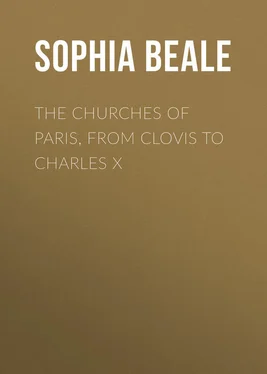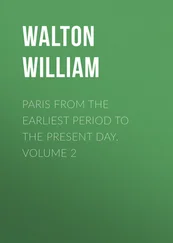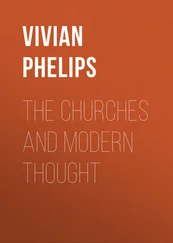Sophia Beale - The Churches of Paris, from Clovis to Charles X
Здесь есть возможность читать онлайн «Sophia Beale - The Churches of Paris, from Clovis to Charles X» — ознакомительный отрывок электронной книги совершенно бесплатно, а после прочтения отрывка купить полную версию. В некоторых случаях можно слушать аудио, скачать через торрент в формате fb2 и присутствует краткое содержание. Жанр: foreign_antique, foreign_prose, на английском языке. Описание произведения, (предисловие) а так же отзывы посетителей доступны на портале библиотеки ЛибКат.
- Название:The Churches of Paris, from Clovis to Charles X
- Автор:
- Жанр:
- Год:неизвестен
- ISBN:нет данных
- Рейтинг книги:3 / 5. Голосов: 1
-
Избранное:Добавить в избранное
- Отзывы:
-
Ваша оценка:
- 60
- 1
- 2
- 3
- 4
- 5
The Churches of Paris, from Clovis to Charles X: краткое содержание, описание и аннотация
Предлагаем к чтению аннотацию, описание, краткое содержание или предисловие (зависит от того, что написал сам автор книги «The Churches of Paris, from Clovis to Charles X»). Если вы не нашли необходимую информацию о книге — напишите в комментариях, мы постараемся отыскать её.
The Churches of Paris, from Clovis to Charles X — читать онлайн ознакомительный отрывок
Ниже представлен текст книги, разбитый по страницам. Система сохранения места последней прочитанной страницы, позволяет с удобством читать онлайн бесплатно книгу «The Churches of Paris, from Clovis to Charles X», без необходимости каждый раз заново искать на чём Вы остановились. Поставьте закладку, и сможете в любой момент перейти на страницу, на которой закончили чтение.
Интервал:
Закладка:
It is not my intention to describe the tomb of Louis XII., or, indeed, any of the others, minutely. Descriptions without illustrations are mostly dry and dreary. Nor have I tried to illustrate the details of ornament in the churches or their contents – in a book of this size it would be impossible; my aim has rather been to give the general effect of their styles; of their everyday appearance; of the life which goes on in and around them; and of the position, especially in the case of S. Denis, of their tombs and furniture. A large photograph and a magnifying glass will show the beauty of the sculpture of the tombs far better than any drawing of mine; for such subjects photography is unique. But for artistic effect, for general impressions of buildings it mostly fails, and all artists will agree with me that, for some reason or other, photographs of buildings seem generally to have been taken from the worst point of view, and are nearly always wanting in impressiveness.
Jean Juste had a brother Antoine, and they seem together to have been the authors of the beautiful tomb of the children of Charles VIII. at Tours; of the fountain called de Beaune, also at Tours; of the two monuments of the famille Gaudin; and the tomb of the général des finances , Thomas Bohier. In 1530, one Juste de Just, tailleur en marbre , living at Tours received 102 livres 10 sous from the king for a Hercules and a Leda. This Juste was probably the same as Jean. The bas-reliefs round the base of Louis XII.'s tomb represent various campaigns of the king; the figures at the four corners are the Cardinal Virtues, those within the arcades are the twelve Apostles. Within are the king and queen, entirely nude, lying upon a mattress in the last agony of death; while above, upon the platform, they are praying before a cushioned faldstool, for their own departed souls. Such is the motive of this and the other two tombs of the same character, those of Henri II. and François I er.
The former of these is the work of Germain Pilon, and was originally placed under the dome of Philibert Delorme's magnificent chapel erected for the Valois family. It is of marble with bronze figures. The king and queen pray upon the housetop; at each end are openings through which are to be seen the figures of the defunct in the sleep of death. The terrible side of death, which is prominent in the expression on the faces of Louis XII. and his queen, is here absent; and Catherine is represented young and beautiful as she appeared at the death of her husband, whom she survived thirty years. At the four corners are bronze figures of the Cardinal Virtues; and the kneeling figures of the sovereigns upon the canopy are also in bronze. The tomb has always been justly esteemed as a magnificent work, and even Bernini admired it. " Le cavalier Bernin ," says Sauval, " a admiré le tombeau de Valois, qui voulait ne rien trouver de passable en France ." The Virtues ornament this tomb also, and present a note-worthy point for Total Abstainers, the figure of Temperance bears two cups; can this be meant for wine as well as water? or for two sorts of water, aërated and mineral?
When the tomb was reconstructed it was found that many of the marbles had antique sculptures upon the back, showing that they had been taken from works of Classic origin.
The monument of François I er.and Claude de France is the largest of these splendid tombs. It was erected about 1552 by Philibert Delorme with the assistance of several sculptors. Pierre Bontems was the author of the bas-reliefs upon the stylobate and some of the kneeling figures upon the canopy; Germain Pilon sculptured the statues of children under the canopy, allegorically representing Fortune, and Ambroise Perret, the Four Evangelists; while the details of ornament were the work of Jacques Chantrel, Bastien Galles, Pierre Bigoigne, and Jean de Bourges. The recumbent figures have been attributed to Jean Goujon, from the exceptional beauty of the workmanship, but without any positive proof. The tomb is of white marble, with a little black and grey introduced for some of the mouldings; the bas-reliefs represent the king's campaigns in Italy. In the bas-reliefs of the Louis XII. monument many of the costumes are more Roman than French; but those upon the tomb of François I er.are treated with more historical truth, and represent the fashion of the day. The faces of the recumbent statues are beautifully modelled; that of the queen bearing an expression of the sanctity with which she was accredited.
S. Denis is rich in columns erected as memorials, often bearing urns upon the top containing some worthy heart. That of François II. was formerly at the church of the Célestins. It is the work of Germain Pilon, and was considered by Sauval and " les habiles gens " to be as beautiful as the "Three Graces" or "Charités" which bore the urn containing the heart of Henri II. The pedestal is triangular, of white marble; so, too, are the three little Genii who guard the corners. One weeps for the defunct; the other two seem to take the matter philosophically. The shaft of the column is dotted over with flames, said to be symbolic of the pillar of fire which marched before the Hebrews; may they not rather mean the flames of purgatory? 32 32 Through the flames of purgatory, we attain the crown. See page 62.
The gilt bronze urn which formerly surmounted it, and the winged child holding a crown, were both consigned to the melting pot. This column was an act of fraternal homage on the part of Charles IX.
The column of Henri III. was originally erected in the church of S. Cloud by the secretary of Henri III., Charles Benoise. The shaft is of red marble, twisted, with ivy twirling round it – the work of Barthélemy Prieur.
The column of the Cardinal Louis de Bourbon formerly bore the effigy of the great man, if honours and emoluments can make a man great. He was naturally a peer; bishop of Laon, of Saintes, of Mans, of Luçon, and of Tréguier; archbishop of Sens; abbot of S. Denis, of Corbie, of Saint-Vincent-de-Laon, of Saint-Faron-de-Meaux, of Ainay, of Saint-Amand, of Saint-Crépin-le-Grand, of Soissons, and of Saint-Serge. And yet some people profess to be scandalised at the excesses of the unprivileged classes!
The cardinal was, however, a great patron of art; at Sens and at Laon, monuments testify to this and all his other magnificences. His body was buried in the cathedral of Laon; the Benedictines of S. Denis only having succeeded in obtaining his heart. The column, like many other beautiful works of art, is by an unknown artist. It is of red marble with a white alabaster base and capital, which is exquisitely sculptured with little figures of children bathed in foliage.
The history of some of the recumbent statues of the kings is curious. Having been made to lie down, they were, after the dispersal of the Musée des Monuments Français, stuck up against the wall of the crypt; and others were rebaptised and renamed. Thus, at the museum, Charles V. and Jeanne de Bourbon became S. Louis and Marguerite de Provence; and so named, when they were trotted back to S. Denis, they received the homage of the faithful. To make matters worse, a copy of S. Louis' statue was sent to Tunis for the church which was built in memory of the saint, and the head became the authentic type for his portraits. The same may be said of the false Marguerite; she wears a costume more than a hundred years too late.
The elaborately enamelled brass slabs of the children of S. Louis, Jean and Blanche, came from Royaument. The design is rude, but the colouring good; the figures are in relief upon a ground incrusted in enamel; the heads and hands, the lions at the feet, and the Angels swinging censers are of polished brass; while the feet and the draperies are in coloured enamel. To see these brasses, permission must be obtained from the architect of the church, as they are upon one side of the High Altar, a part which is not generally shown to ordinary visitors. The motto upon the tomb of Jean is as follows:
Читать дальшеИнтервал:
Закладка:
Похожие книги на «The Churches of Paris, from Clovis to Charles X»
Представляем Вашему вниманию похожие книги на «The Churches of Paris, from Clovis to Charles X» списком для выбора. Мы отобрали схожую по названию и смыслу литературу в надежде предоставить читателям больше вариантов отыскать новые, интересные, ещё непрочитанные произведения.
Обсуждение, отзывы о книге «The Churches of Paris, from Clovis to Charles X» и просто собственные мнения читателей. Оставьте ваши комментарии, напишите, что Вы думаете о произведении, его смысле или главных героях. Укажите что конкретно понравилось, а что нет, и почему Вы так считаете.




![Theresa Cheung - The Dream Dictionary from A to Z [Revised edition] - The Ultimate A–Z to Interpret the Secrets of Your Dreams](/books/692092/theresa-cheung-the-dream-dictionary-from-a-to-z-r-thumb.webp)







